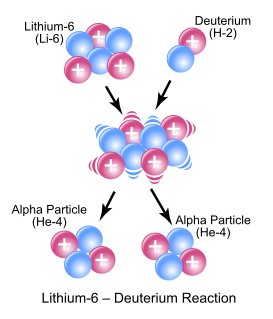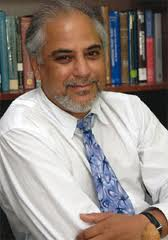
SLAC National Accelerator Laboratory, originally named Stanford Linear Accelerator Center, is a United States Department of Energy National Laboratory operated by Stanford University under the programmatic direction of the U.S. Department of Energy Office of Science and located in Menlo Park, California. It is the site of the Stanford Linear Accelerator, a 3.2 kilometer linear accelerator constructed in 1966 and shut down in the 2000s, which could accelerate electrons to energies of 50 GeV.

Neutron generators are neutron source devices which contain compact linear particle accelerators and that produce neutrons by fusing isotopes of hydrogen together. The fusion reactions take place in these devices by accelerating either deuterium, tritium, or a mixture of these two isotopes into a metal hydride target which also contains deuterium, tritium or a mixture of these isotopes. Fusion of deuterium atoms results in the formation of a He-3 ion and a neutron with a kinetic energy of approximately 2.5 MeV. Fusion of a deuterium and a tritium atom results in the formation of a He-4 ion and a neutron with a kinetic energy of approximately 14.1 MeV. Neutron generators have applications in medicine, security, and materials analysis.

A free-electron laser (FEL) is a synchrotron light source producing extremely brilliant and short pulses of synchrotron radiation. An FEL functions and behaves in many ways like a laser, but instead of using stimulated emission from atomic or molecular excitations, it employs relativistic electrons as a gain medium. Synchrotron radiation is generated as a bunch of electrons passes through a magnetic structure. In an FEL, this radiation is further amplified as the synchrotron radiation re-interacts with the electron bunch such that the electrons start to emit coherently, thus allowing an exponential increase in overall radiation intensity.
The Z Pulsed Power Facility, informally known as the Z machine, is the largest high frequency electromagnetic wave generator in the world and is designed to test materials in conditions of extreme temperature and pressure. Since its refurbishment in October 1996 it has been used primarily as an inertial confinement fusion (ICF) research facility. Operated by Sandia National Laboratories, it gathers data to aid in computer modeling of nuclear weapons and eventual nuclear fusion pulsed power plants. The Z machine is located at Sandia's main site in Albuquerque, New Mexico.
A particle beam is a stream of charged or neutral particles, in many cases moving at near the speed of light.

Aneutronic fusion is any form of fusion power in which the majority of the energy released is carried by charged particles. While the lowest-threshold nuclear fusion reactions release up to 80% of their energy in the form of (uncharged) neutrons, there also exist reactions in which the energy is released in the form of charged particles, typically protons or alpha particles. Successful aneutronic fusion would greatly reduce problems associated with neutron radiation such as ionizing damage, neutron activation and requirements for biological shielding, remote handling and safety.
Plasma acceleration is a technique for accelerating charged particles, such as electrons, positrons, and ions, using the electric field associated with electron plasma wave or other high-gradient plasma structures. The plasma acceleration structures are created either using ultra-short laser pulses or energetic particle beams that are matched to the plasma parameters. These techniques offer a way to build high performance particle accelerators of much smaller size than conventional devices. The basic concepts of plasma acceleration and its possibilities were originally conceived by Toshiki Tajima and Prof. John M. Dawson of UCLA in 1979. The initial experimental designs for a "wakefield" accelerator were conceived at UCLA by Prof. Chan Joshi et al. Current experimental devices show accelerating gradients several orders of magnitude better than current particle accelerators over very short distances, and about one order of magnitude better at the one meter scale.

Thomas Jefferson National Accelerator Facility (TJNAF), commonly called Jefferson Lab or JLab, is a US National Laboratory located in Newport News, Virginia. Its stated mission is "to provide forefront scientific facilities, opportunities and leadership essential for discovering the fundamental structure of nuclear matter; to partner in industry to apply its advanced technology; and to serve the nation and its communities through education and public outreach."

Nova was a high-power laser built at the Lawrence Livermore National Laboratory (LLNL) in California, United States, in 1984 which conducted advanced inertial confinement fusion (ICF) experiments until its dismantling in 1999. Nova was the first ICF experiment built with the intention of reaching "ignition", a chain reaction of nuclear fusion that releases a large amount of energy. Although Nova failed in this goal, the data it generated clearly defined the problem as being mostly a result of Rayleigh–Taylor instability, leading to the design of the National Ignition Facility, Nova's successor. Nova also generated considerable amounts of data on high-density matter physics, regardless of the lack of ignition, which is useful both in fusion power and nuclear weapons research.
Ultrafast laser spectroscopy is a spectroscopic technique that uses ultrashort pulse lasers for the study of dynamics on extremely short time scales. Different methods are used to examine the dynamics of charge carriers, atoms, and molecules. Many different procedures have been developed spanning different time scales and photon energy ranges; some common methods are listed below.
The High Power laser Energy Research facility (HiPER), is a proposed experimental laser-driven inertial confinement fusion (ICF) device undergoing preliminary design for possible construction in the European Union. As of 2019, the effort appears to be inactive.
Accelerators and Lasers In Combined Experiments (ALICE), or Energy Recovery Linac Prototype (ERLP) is a 35MeV energy recovery linac test facility at Daresbury Laboratory in Cheshire, England. The project was originally conceived as a test bed for 4GLS, and consists of:

The Trident Laser is a high power, sub-petawatt class, solid-state laser facility located at Los Alamos National Laboratory, in Los Alamos, New Mexico, originally built in the late 1980s for Inertial confinement fusion (ICF) research by KMS Fusion, founded by Kip Siegel, in Ann Arbor, Michigan, it was later moved to Los Alamos in the early 1990s to be used in ICF and materials research. The system is now being decommissioned with final laser experiments being completed February 2017.

Swapan Chattopadhyay CorrFRSE is a particle accelerator physicist noted for his pioneering contributions of innovative concepts, techniques and developments in high energy particle colliders, coherent and incoherent light sources, ultrafast sciences in the femto- and atto- second regimes, superconducting linear accelerators and various applications of interaction of particle and light beams. He has directly contributed to the development of many accelerators around the world, e.g. the Super Proton-Antiproton Synchrotron at CERN, the Advanced Light Source at Berkeley, the asymmetric-energy electron-positron collider PEP-II at Stanford, the Continuous Electron Beam Accelerator facility (CEBAF) at Jefferson Lab and the Free-Electron Lasers at Jefferson and Daresbury Laboratories.

A particle accelerator is a machine that uses electromagnetic fields to propel charged particles to very high speeds and energies, and to contain them in well-defined beams.

The Extreme Light Infrastructure (ELI) is a Research Infrastructure (RI) of pan-European interest and part of the European ESFRI Roadmap. ELI hosts the most intense beamline system worldwide, develop new interdisciplinary research opportunities with light from these lasers and secondary radiation derived from them, and make them available to the international scientific user community. ELI aims to be the world's biggest and first international user facility in beamline and laser research.
Central Laser Facility (CLF) is a research facility in the UK. It is part of the Rutherford Appleton Laboratory. The facility is dedicated to studying the applications of high energy lasers. It was opened in 1976. As of 2013 there are 5 active laser laboratories at the CLF: Vulcan, Astra Gemini, Artemis, ULTRA, and OCTOPUS. The facility provides both high-power and high-sensitivity lasers for study across broad fields of science from atomic and plasma physics to medical diagnostics, biochemistry and environmental science. Also through the Centre for Advanced Laser Technology and Application (CALTA), CLF is responsible for laser development. DiPOLE is the brainchild of that project.
Chandrashekhar "Chan" Janardan Joshi is an Indian-American experimental plasma physicist. He is known for his pioneering work in plasma-based particle acceleration techniques for which he won the 2006 James Clerk Maxwell Prize for Plasma Physics. He is currently Distinguished Professor of Electrical Engineering, the director of the Center for High Frequency Electronics and the head of the Neptune Laboratory for Advanced Accelerator Research at UCLA.
Victor Malka is a French plasma physicist and a pioneer in laser plasma acceleration. In 2004, Malka demonstrated that high energy monoenergetic electron beams could be generated using the technique of laser wakefield acceleration, and subsequently used them to develop compact X-ray and gamma radiation sources with applications in medicine, security technology and phase-contrast imaging. For these contributions to the field, he was awarded the IEEE Particle Accelerator Science and Technology Award in 2007, the Julius Springer Prize for Applied Physics in 2017, and the Hannes Alfvén Prize in 2019.










